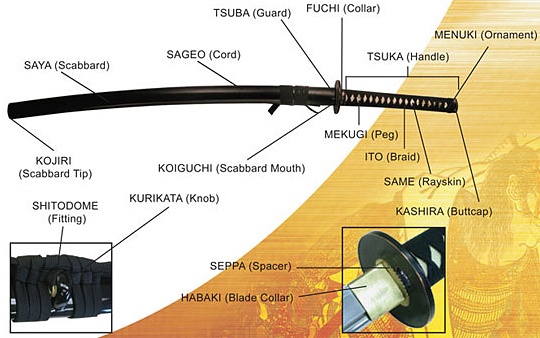So, I now have my own, custom-made sword. It is Chinese made but was forged in the traditional manner. It is folded steel that has been differentially heated. I have made it a goal of mine to learn the Japanese terminology for the parts of the sword. I have found the whole experience fascinating. I have looked over numerous Youtube clips and other websites in my eagerness for knowledge.
So what do I know at this point (excuse the pun)?
Kissaski - the point of the sword.
Mune - the back of the blade.
Ha - the edge of the blade.
Hamon - the wavy line on the blade.
Tsuba - the guard.
Habaki - the brass piece that links blade to handle.
Seppa - the brass spacers.
Mekugi - peg that holds handle to tang.
Tsuka - the whole handle.
Same - ray skin wrap.
Saya - scabbard.
Sageo - scabbard cord.
This picture tells the story...
Of course knowing the parts of the sword allow me to look into sword disassembly and care but it is a tool for conflict and ultimately I do TSYR to learn how to use this weapon.
First there is the practise of battojutsu, or sword drawing. It is a precise discipline and there is much to be gleaned in the four kata we learn at the basic level.
However, the real challenge is simple suburi, the repetition of simple movements such as men strikes. I can swing a bokken through 100 cuts but today, I cut with my sword for 50 cuts and found that swinging a piece of steel about requires conditioning. Something I do not have as of yet. I sit writing this with aching wrists, shoulders and back muscles (also an indication that my technique is poor).
I have a long journey ahead with my sword work, it is by far the weakest part of my practice. However, having my own blade and learning its balance, weight and length is enjoyable.
Now, back to training!


No comments:
Post a Comment